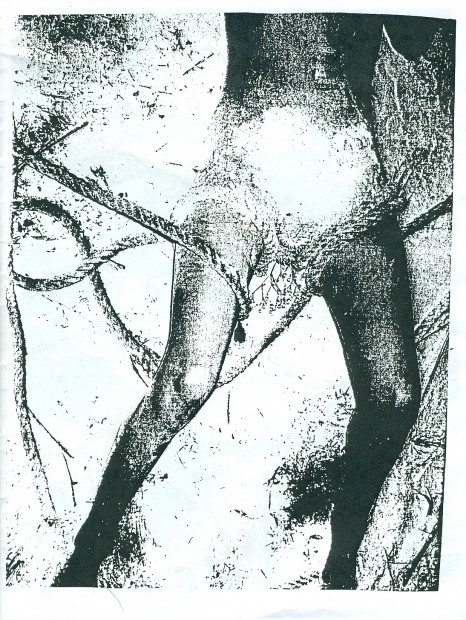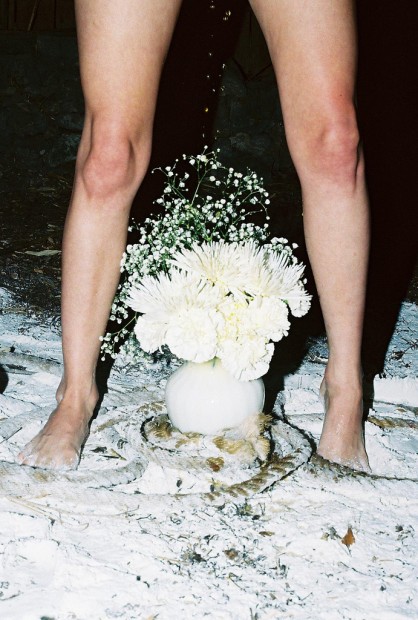Mikaylah Bowman‘s recent series of photographs reminds me of the 17th century Dutch still-life tradition, paintings that depict neatly arranged flowers, their edges crisp with decay. Something sweet and slightly sinister. Flowers are a prominent theme in Bowman’s work, perhaps pointing to the very clichés they so often engender–female fragility, soft scents, forgiveness. In one photograph a pair of knobby knee-ed legs straddle a bouquet, a stream of pee trickles down onto the arrangement below. In another a nude body lays on a flour filled ground, a small selection of flowers, something you’d hold in your fist, emerges from the figure’s vagina. Dahlias, Strawflowers, Carnations, Lilys, Baby’s Breath, Spidermum.
The photographs are currently on display at Red Space Gallery and also feature rope loosely wrapped around legs or configured to hang from a tree, a nest for holding a small figure. Flour appears as a dusting of chalky white against the flare of the flash, making the photographs feel bound to material components rather than just as flat things in the world. No faces are evident, only torsos and legs and feet dangling. The images are part Katy Grannan, part Otto Muehl, and part Flowers in the Attic.
The title of the exhibition, La Fille Qui Ment, or translated, The Girl Who Lies, suggests both a cunning girl and a prostrate girl. To lie and to lie. A zine with the same title accompanies the exhibition and through photocopied images and sections of text lifted from William Gaddis, Octave Mirbeau, and J.K. Huysmans, Bowman creates dense and poetic associations. “Can you imagine being introduced to yourself? You can’t.” And “The literal translation of the German word, niederlage, is to lie under.” And “She’s still sick with trench mouth. She got it kissing the Pope’s ring.” The slim book acts as a type of index to the series of photographs presented in the exhibition.
 The gallery floor is covered in hay and fake flowers hang from the ceiling. These additions to the installation feels cloying and closed-in, but perhaps that too is the point–like the time my friend placed a piece of potpourri in her mouth mistaking it for a candy. There is one photograph that I might have edited from the series and maybe I’d tell Bowman to be more careful with her affectations–why, for instance, is the title in French? Regardless, this young artist has created a distinct and strong aesthetic–a vanitas, an elegy to romanticism, the toughness of a flower.
The gallery floor is covered in hay and fake flowers hang from the ceiling. These additions to the installation feels cloying and closed-in, but perhaps that too is the point–like the time my friend placed a piece of potpourri in her mouth mistaking it for a candy. There is one photograph that I might have edited from the series and maybe I’d tell Bowman to be more careful with her affectations–why, for instance, is the title in French? Regardless, this young artist has created a distinct and strong aesthetic–a vanitas, an elegy to romanticism, the toughness of a flower.





